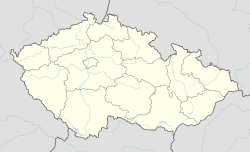Jablunkov
|
Jablunkov Jabłonków |
|||
|---|---|---|---|
| Town | |||

Part of town square with Corpus Christi Church
|
|||
|
|||
| Location in the Czech Republic | |||
| Coordinates: 49°34′28″N 18°45′58″E / 49.57444°N 18.76611°ECoordinates: 49°34′28″N 18°45′58″E / 49.57444°N 18.76611°E | |||
| Country | Czech Republic | ||
| Region | Moravian-Silesian | ||
| District | Frýdek-Místek | ||
| First mentioned | 1435 | ||
| Town rights | 1560 | ||
| Government | |||
| • Mayor | Ing. Jiří Hamrozi (2014) | ||
| Area | |||
| • Total | 10.39 km2 (4.01 sq mi) | ||
| Elevation | 386 m (1,266 ft) | ||
| Population (2011) | |||
| • Total | 5,649 | ||
| • Density | 540/km2 (1,400/sq mi) | ||
| Postal code | 739 91 | ||
| Website | www |
||
Jablunkov (Czech pronunciation: [ˈjabluŋkof]; Polish: Jabłonków , German: Jablunkau) is a town in Frýdek-Místek District, Moravian-Silesian Region of the Czech Republic. It has a population of 5,750 (2006), 23% of the population are Poles. Jablunkov lies between the Silesian and Moravian-Silesian Beskids mountain ranges, in the historical region of Cieszyn Silesia, and is the easternmost town of the country. The Lomná River flows into the Olza River in the town.
According to historians, the beginnings of Jablunkov are to be found in the place where the present-day village of Hrádek is located. It was first mentioned in a written document in 1435. This settlement was primordially named Jablonka and as such it was mentioned as a seat of a Catholic parish in the register of Peter's Pence payment from 1447 among 50 parishes of Teschen deanery. In the same year Magyars completely destroyed the settlement. Politically it belonged to the Duchy of Teschen, a fee of the Kingdom of Bohemia which was since 1526 a part of the Habsburg Monarchy. In 1560 Wacław III, Duke of Cieszyn, granted town rights to the town. It continuously developed and by the end of the 16th century it had a mayor and a city council. The town profited from its location in the Jablunkov Pass. It was located on an ancient trade route going from the Mediterranean Sea to the Baltic Sea. The route was used by merchants of ancient Rome; frequent discoveries of Roman coins confirm that. Important trading routes to Kraków (north) and to Upper Hungary (east) also run through the town. It became more and more important and also rich, as many citizens lived by trading. In the middle of the 17th century, it had, together with a suburb and a village of Pioseczna, 750 inhabitants. In the 18th century most of citizens worked in trade, craftsmanship and farming. At the end of the 19th century, many new buildings were built. A new Art Nouveau town hall was built in 1905.
...
Wikipedia



